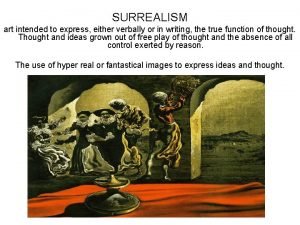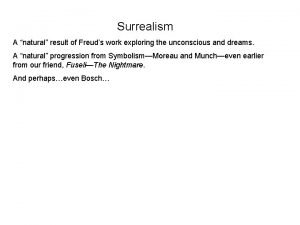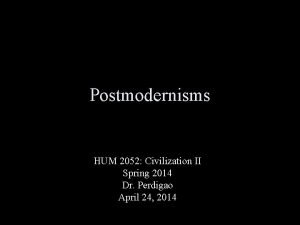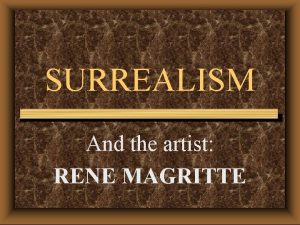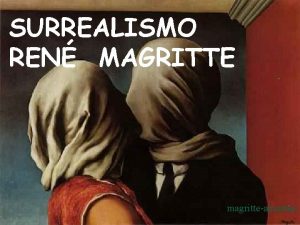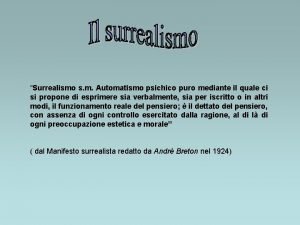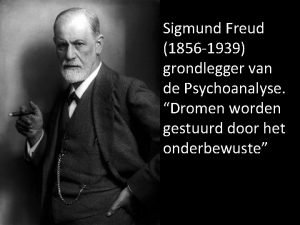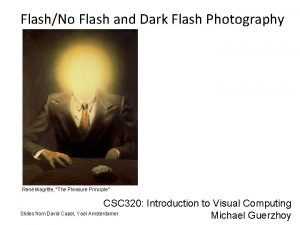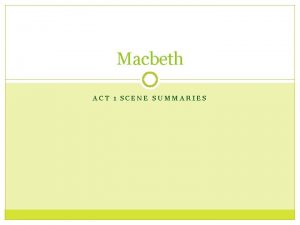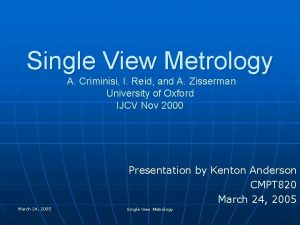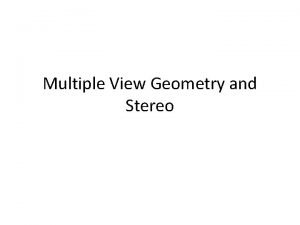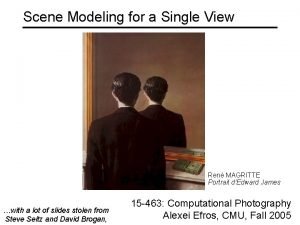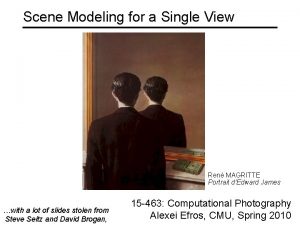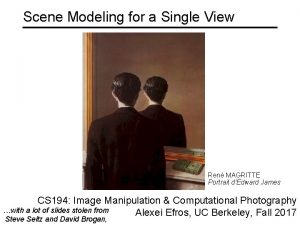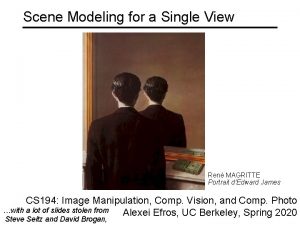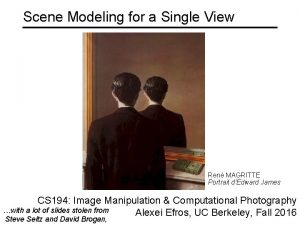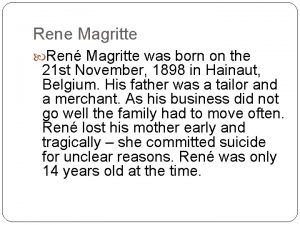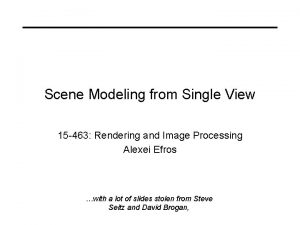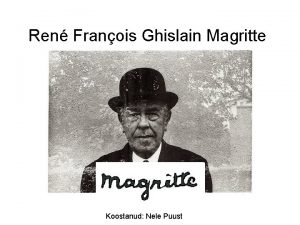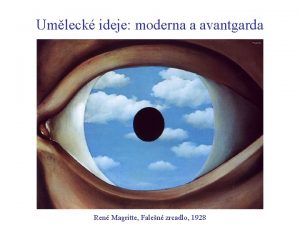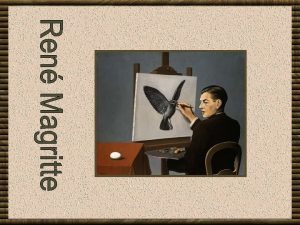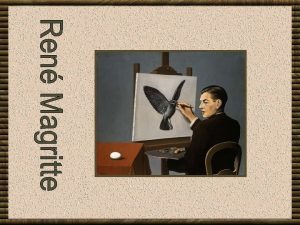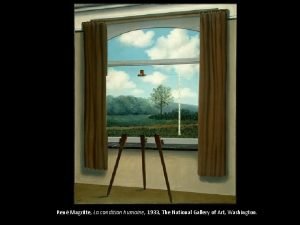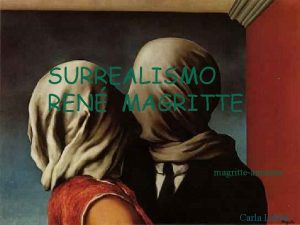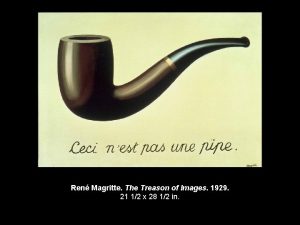Scene Modeling for a Single View Ren MAGRITTE










































- Slides: 42

Scene Modeling for a Single View René MAGRITTE Portrait d'Edward James CS 194: Image Manipulation & Computational Photography …with a lot of slides stolen from Alexei Efros, UC Berkeley, Fall 2016 Steve Seitz and David Brogan,

Breaking out of 2 D …now we are ready to break out of 2 D And enter the real world!

on to 3 D… Enough of images! We want more of the plenoptic function We want real 3 D scene walk-throughs: Camera rotation Camera translation Can we do it from a single photograph?

Camera rotations with homographies Original image St. Petersburg photo by A. Tikhonov Virtual camera rotations

Camera translation Does it work? synthetic PP PP 1 PP 2

Yes, with planar scene (or far away) PP 3 PP 1 PP 2 PP 3 is a projection plane of both centers of projection, so we are OK!

So, what can we do here? Model the scene as a set of planes! Now, just need to find the orientations of these planes.

Some preliminaries: projective geometry Ames Room

Silly Euclid: Trix are for kids! Parallel lines? ? ?

The projective plane Why do we need homogeneous coordinates? • represent points at infinity, homographies, perspective projection, multi-view relationships What is the geometric intuition? • a point in the image is a ray in projective space y (x, y, 1) (0, 0, 0) z x (sx, sy, s) image plane • Each point (x, y) on the plane is represented by a ray (sx, sy, s) – all points on the ray are equivalent: (x, y, 1) (sx, sy, s)

Projective lines What does a line in the image correspond to in projective space? • A line is a plane of rays through origin – all rays (x, y, z) satisfying: ax + by + cz = 0 l p • A line is also represented as a homogeneous 3 -vector l

Point and line duality • A line l is a homogeneous 3 -vector • It is to every point (ray) p on the line: l p=0 l p 1 p 2 l 1 p l 2 What is the line l spanned by rays p 1 and p 2 ? • l is to p 1 and p 2 l = p 1 p 2 • l is the plane normal What is the intersection of two lines l 1 and l 2 ? • p is to l 1 and l 2 p = l 1 l 2 Points and lines are dual in projective space • given any formula, can switch the meanings of points and lines to get another formula

Ideal points and lines y (sx, sy, 0) z x image plane Ideal point (“point at infinity”) • p (x, y, 0) – parallel to image plane • It has infinite image coordinates Ideal line • l (0, 0, 1) – parallel to image plane

Vanishing points image plane vanishing point camera center ground plane Vanishing point • projection of a point at infinity

Vanishing points (2 D) image plane vanishing point camera center line on ground plane

Vanishing points image plane vanishing point V camera center C line on ground plane Properties • Any two parallel lines have the same vanishing point v • The ray from C through v is parallel to the lines • An image may have more than one vanishing point

Vanishing lines v 1 v 2 Multiple Vanishing Points • Any set of parallel lines on the plane define a vanishing point • The union of all of these vanishing points is the horizon line – also called vanishing line • Note that different planes define different vanishing lines

Vanishing lines Multiple Vanishing Points • Any set of parallel lines on the plane define a vanishing point • The union of all of these vanishing points is the horizon line – also called vanishing line • Note that different planes define different vanishing lines

Computing vanishing points V P 0 D Properties • P is a point at infinity, v is its projection • They depend only on line direction • Parallel lines P 0 + t. D, P 1 + t. D intersect at P

Computing vanishing lines C l ground plane Properties • l is intersection of horizontal plane through C with image plane • Compute l from two sets of parallel lines on ground plane • All points at same height as C project to l – points higher than C project above l • Provides way of comparing height of objects in the scene


Fun with vanishing points

“Tour into the Picture” (SIGGRAPH ’ 97) Create a 3 D “theatre stage” of five billboards Specify foreground objects through bounding polygons Use camera transformations to navigate through the scene

The idea Many scenes (especially paintings), can be represented as an axis-aligned box volume (i. e. a stage) Key assumptions: • All walls of volume are orthogonal • Camera view plane is parallel to back of volume • Camera up is normal to volume bottom How many vanishing points does the box have? • Three, but two at infinity • Single-point perspective Can use the vanishing point to fit the box to the particular Scene!

Fitting the box volume User controls the inner box and the vanishing point placement (# of DOF? ? ? ) Q: What’s the significance of the vanishing point location? A: It’s at eye level: ray from COP to VP is perpendicular to image plane.

Example of user input: vanishing point and back face of view volume are defined High Camera

Example of user input: vanishing point and back face of view volume are defined High Camera

Example of user input: vanishing point and back face of view volume are defined Low Camera

Example of user input: vanishing point and back face of view volume are defined Low Camera

Comparison of how image is subdivided based on two different camera positions. You should see how moving the box corresponds to moving the eyepoint in the 3 D world. High Camera Low Camera

Another example of user input: vanishing point and back face of view volume are defined Left Camera

Another example of user input: vanishing point and back face of view volume are defined Left Camera

Another example of user input: vanishing point and back face of view volume are defined Right Camera

Another example of user input: vanishing point and back face of view volume are defined Right Camera

Comparison of two camera placements – left and right. Corresponding subdivisions match view you would see if you looked down a hallway. Left Camera Right Camera

2 D to 3 D conversion First, we can get ratios left right top vanishing point back plane bottom

2 D to 3 D conversion • Size of user-defined back plane must equal size of camera plane (orthogonal sides) • Use top versus side ratio to determine relative left right height and width top dimensions of box • Left/right and top/bot camera ratios determine part of bottom pos 3 D camera placement

Depth of the box Can compute by similar triangles (CVA vs. CV’A’) Need to know focal length f (or FOV) Note: can compute position on any object on the ground • Simple unprojection • What about things off the ground?

DEMO Now, we know the 3 D geometry of the box We can texture-map the box walls with texture from the image

Foreground Objects Use separate billboard for each For this to work, three separate images used: • Original image. • Mask to isolate desired foreground images. • Background with objects removed

Foreground Objects Add vertical rectangles for each foreground object Can compute 3 D coordinates P 0, P 1 since they are on known plane. P 2, P 3 can be computed as before (similar triangles)

Foreground DEMO
 Helen c erickson
Helen c erickson Relational vs dimensional data modeling
Relational vs dimensional data modeling Surrealist artists were interested exploring
Surrealist artists were interested exploring Rene magritte not to be reproduced
Rene magritte not to be reproduced Boston magritte eye
Boston magritte eye Apparizione di un volto e di una fruttiera sulla spiaggia
Apparizione di un volto e di una fruttiera sulla spiaggia I due amanti magritte
I due amanti magritte Giacomo balla futurismo
Giacomo balla futurismo Nature morte vivante
Nature morte vivante Dislocation surrealism definition
Dislocation surrealism definition Magritte i principi dell'autunno
Magritte i principi dell'autunno Magritte la condition humaine
Magritte la condition humaine Magritte o descartes
Magritte o descartes Meditation rene magritte
Meditation rene magritte Ismos del siglo 20
Ismos del siglo 20 Automatismo psichico surrealismo
Automatismo psichico surrealismo Human condition magritte
Human condition magritte Magritte attempting the impossible
Magritte attempting the impossible Surrealism rene magritte
Surrealism rene magritte Homesickness magritte
Homesickness magritte Magritte le viol
Magritte le viol Magritte light dark
Magritte light dark Surrealismo
Surrealismo Suncg
Suncg Macbeth summary act 1
Macbeth summary act 1 Multiple instruction single data
Multiple instruction single data Dataxin
Dataxin Waiting line management
Waiting line management Scene summaries macbeth
Scene summaries macbeth Single view metrology
Single view metrology Single view geometry
Single view geometry Single view geometry
Single view geometry Single view of the citizen
Single view of the citizen Kontinuitetshantering i praktiken
Kontinuitetshantering i praktiken Typiska drag för en novell
Typiska drag för en novell Nationell inriktning för artificiell intelligens
Nationell inriktning för artificiell intelligens Vad står k.r.å.k.a.n för
Vad står k.r.å.k.a.n för Varför kallas perioden 1918-1939 för mellankrigstiden
Varför kallas perioden 1918-1939 för mellankrigstiden En lathund för arbete med kontinuitetshantering
En lathund för arbete med kontinuitetshantering Underlag för särskild löneskatt på pensionskostnader
Underlag för särskild löneskatt på pensionskostnader Tidbok yrkesförare
Tidbok yrkesförare Sura för anatom
Sura för anatom Densitet vatten
Densitet vatten


